| enter keyword to search: |
|
Images db
|
|
|
Articles db
|
|
|
|
|
|
|
|
Translation into stone of the beliefs of a mystic king |
|
The Bayon remains one of the most enigmatic temple of Angkor. Built by King Jayavarman VII, Angkor’s greatest ruler, at the centre of Angkor Thom its regal city, the Bayon is an interesting mixture of Hindu and Buddhist elements. The Bayon is mainly a Buddhist temple with its famous enormous faces of Bodhisattva Lokesvara, even though the bas relief's of the galleries display scenes from Hindu mythology. The temple core is the inner terrace, where the main sanctuary tower is erected, crammed inside the second gallery in such a way that there is practically no space to walk around. Most of the faces of the towers have been reconstructed, from wherever one views it, this temple appears like a chaos of stones with the masked towers rearing one on top of the other with the ruins of the central tower rising towards the sky reinforcing the sense of height. Only walking on the inner raised terrace it is possible to gain an idea of the complicated plan, wherever one wanders the visitor is literally overwhelmed by the towers that dominate with the serene smiles of Lokesvara faces.
Bayon |
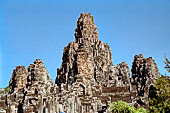
|
The third enclosure was formed by a gallery with, on one side, the wall of the famous bas
relief's and, on the other, a vaulted aisle, the gallery had four corner pavilions and four axial gopuras. Everything now have disappeared, what remains are rows of pillars and, fortunately, the walls of the bas reliefs. The main temple entrance is the east gopura III or better what remains of it: a number of square pillars with lovely bas-relief of dancing apsaras on lotus shaped niches. On the walls of the third enclosure there are more than 1.200 metres of bas-reliefs showing scenes from everyday life and battles. Once inside the courtyard enclosed by the third enclosure on the right and on the left the ruins of two high
'libraries'.
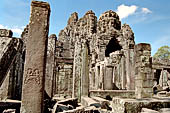
|
Bayon
|
The second enclosure is a system of galleries forming a cross inside a square, enclosing very tightly the terrace of the third level. On every corner of the square and of the cross there is a corner tower each one with the faces of Lokesvara. On every sides of the enclosure there are three towers with the central one forming the entrance, every tower is decorated with the four faces of Lokesvara.
Bayon |
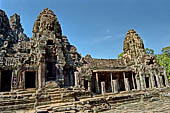
|
The first enclosure coincides with the raised platform (the third level), its outline follows very closely the cross plan of the second enclosure. The platform is reached by a flight of steps corresponding to the west and south entrance gopura.
The 43 metres high central tower, corresponding to the Hindu sikkara, has an unusual circular plan given by the addition of radiating
vestibules to the original cruciform plan corresponding, at the higher level, to eight towers of which only one of them has still a face in its entirety. Perhaps also the top of the tower, now disintegrated, was decorated with the four faces like the others. The central tower originally housed a 3m high Buddha statue sitting on the coils of a naga, the statue was destroyed during the xiii c.
Hindu restoration and was found by modern time archaeologist broken in a well, now it is completely restored. Around the central tower a series of chambers and two ‘libraries’ all with face towers.
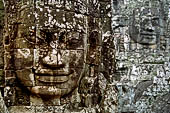
|
Bayon
|
The bas-reliefs
East wall of the 3rd enclosure
On the south section of the wall is shown a military procession marching from south to north with accompanying musicians, the chiefs are on elephants guided by their drivers who brandish the usual hooks, they are armed with bows or javelins and surrounded by parasols. One can see the army suppliers - the covered carts with axle-skates are exactly the same as those still in use today. On the upper panel, three princesses pass by, carried in rich palanquins. Passing the door to the courtyard the same procession but with reversed direction of the march.
On the north section of the wall the battle of Cham and Khmer with elephants taking part in it.
South wall of the 3rd enclosure
The east section of the wall, one of the best, depicts a naval combat between Khmer and Chams. The king is sitting in his palace giving orders. Numerous species of fish are shown, often amongst the trees of the flooded forest a feature that one can still find in the Tonlé Sap today. On a lower register events from everyday life, market scenes, open-air cooking, hunting and fishing, familiar scenes including a cock fight but also palace scenes like princesses surrounded by their servants, games of chess.
Bayon |
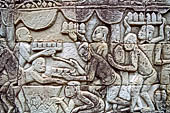
|
East gopura of the 2nd enclosure
In the northern part of the east gopura II: a large army parade with below infantrymen framed by cavaliers. Above is a cart on six wheels carried or pulled on shoulders and occupied by a prince between two women, followed by princesses in palanquins. Passing the door a small panel shows a prince at Shiva’s feet. Two boats float on a pool surrounded by fish. A flight of apsaras and birds crowns the composition. Between the towers
the bas relief of 'the legend of the Leper King' from left to right:
the king in his palace surrounded by his courtiers and dancers, the king fights with a serpent, while below, the crowd looks on
(by common beliefs leprosy was contracted by the snake’s venom). Interesting to note, under this scene, there is a removable stone that serves as a plug for an internal channel for the evacuation of water.
| |
|
|
 |
|
|



